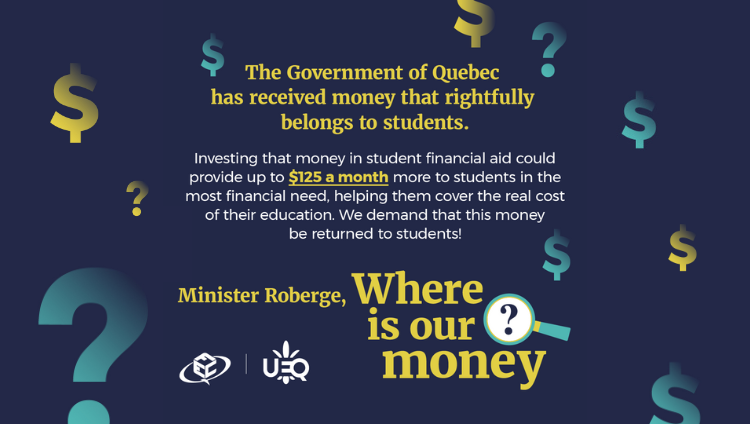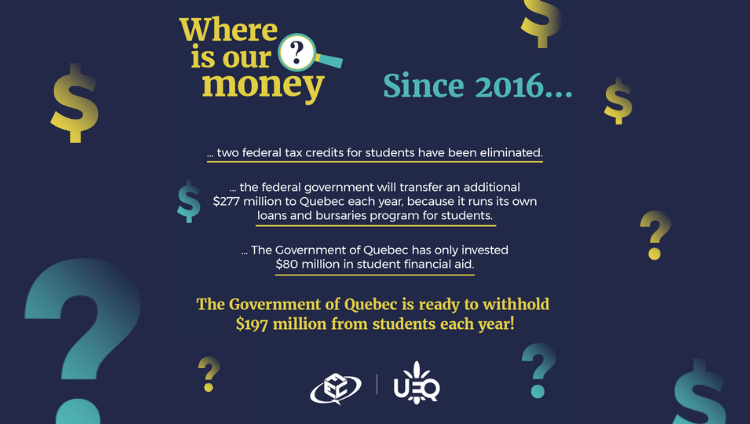What request are the FECQ and QSU making?
The national associations have called on the Government of Quebec to invest all of these funds into Student Financial Aid. Specifically, we want the funds to be used to increase living expenses recognized by the program to make up for years in which those expenses were frozen. As it stands, recognized living expenses need to be increased by 12% simply to catch up to the actual costs of living. Our goal is to ensure that students with the most financial need are able to cover the real cost of their education.
What have the FECQ and the QSU done so far to advance their demand?
First, the QSU documented the situation to ensure it fully understood every aspect of what was taking place. A detailed calculation of the amounts transferred by the federal government and analysis of Quebec’s budget provide the foundation of that effort. Over the past three months, the QSU and FECQ have sought to open discussions with the government to ensure that all of the funds owed are transferred to Quebec’s Student Financial Aid program.
What are students in Quebec losing as a result of the government’s inaction?
Students in Quebec have yet to recover the money that they can no longer claim after the elimination of these tax credits. In 2016, students in Quebec could claim these tax credits, and that is no longer the case. This means that students in Quebec stand to lose the equivalent of $277 million in 2020. Only $80 million has been invested in financial aid. As a result, students have lost $197 million.
Why should this money be invested in Student Financial Aid?
Because the federal transfer is the result of investments in the Canadian loans and grants programs. This transfer is made each year because Quebec students don’t have access to the Canadian programs, because the province operates its own program. The transfer is intended to compensate Quebec students. We believe that the best way to do that is to invest the funds in Student Financial Aid.
Why aren’t the funds sent directly into the Student Financial Aid program?
Quebec withdrew from the Canadian program to instead develop its own. The Quebec loans and bursaries program is administered entirely by the Government of Quebec. According to the Canada Student Financial Assistance Act (S.C. 1994, c. 28), provinces that don’t participate in it instead receive a compensatory transfer. These transfers are made without any restrictions on their use.
Why hasn’t the federal transfer stayed the same since 2016, and why are you asking for more money now?
The amount has increased because the federal government has continued to improve its student loan and grant programs. It has therefore continued to invest new funds and must provide a fair compensation to provinces that don’t participate in it.
What’s more, the 2019 federal budget announced a new investment in student loans and grants to lower interest rates for program beneficiaries. It will invest $1.7 billion over five years. For Quebec, this represents an additional $92 million a year, over five years. The Conseil du trésor should receive the first transfer for these new funds on January 31, 2020.
Why did you ask for $80 million in 2016 but want more now?
In 2016, the $80 million more or less represented the average amount for the transfer over three years, according to the investments announced in the 2016 federal budget. New investments by the federal government into its own loan and grant programs led to an increase in federal transfers to the province. The more Canada invests, the more Quebec’s share increases.
Is this amount ($197 million) recurrent?
Yes, because it is the result permanent improvements to the Canadian program. The investment is therefore recurring, meaning that the transfers will be maintained. If any new investments are made in the Canadian program, new funds will be transferred to the province.
Why is the federal government investing in its loan and grant programs?
As a result of demands made by the student community, which wants more financial support for students while they are studying, rather than afterwards. As such, two tax credits for education were eliminated in 2016 and existing student loan and grant programs were improved, as they allow students to receive financial support while they’re studying. The Canadian government has also focused more on funding for higher education since the Liberals were elected in 2015. Indeed, the government is continuing to work in this direction.
Does investing this money in Quebec’s student financial aid program represent a form of interference by the Canadian government in a provincial jurisdiction?
No, since the Canadian government is merely giving Quebec the ability to compensate students for the money they’ve lost after the tax credits were eliminated. Indeed, it cannot impose any obligations on how the Government of Quebec uses the funds. Quebec’s student associations are the ones asking that this money be used to improve the Student Financial Aid program.
What could this money be used for?
One way to use these funds would be to increase the amounts recognized for living expenses, since the program no longer represents the real cost of living. Studies show that the actual cost of living in 2018 was $1,029/month, while the financial aid program provides only $913/month. We propose bringing all of these expenses back up to date, which would give 25,000 new beneficiaries access to financial aid, particularly among those who are on the edge of not receiving any loans or bursaries. This change would also allow students with the most financial need to receive more support through bursaries, as much as $800 more for undergraduate students.
Where is this money currently being spent?
Because the federal government can’t place any limits on how Quebec uses the funds, the province can use them however it sees fit. This means that the federal transfer can be used for anything at all. It could go towards scholarships for academic excellence, to fund pre-kindergarten classes, towards maintenance for government buildings, or building bridges! In 2016, the Liberal government was using this money to pay for infrastructure, so it wouldn’t be surprising to find it going towards a similar purpose.


